Willingness to Participate in Vehicle-to-Everything (V2X) in Sweden, 2022—Using an Electric Vehicle’s Battery for More Than Transport
Abstract
1. Introduction
2. Overview of Vehicle-to-Everything
3. Data Collection
4. Results of the Questionnaire
5. Comments and Discussions
6. Conclusions and Policy Implications
- As an important finding through the questionnaire, it was emphasized that Swedish EV owners are more interested in V2H than V2G for the V2X implementation. They think having the electric car as a back-up power at home is more important, and a majority were willing to pay extra for an electric car with V2H functionality.
- The participants in this study were less concerned about battery degradation, range anxiety, and EV warranty, compared to other studies. One reason for this could be that a majority of the respondents were male, who were less concerned about these aspects compared to the female respondents.
- The participants showed a high interest in having full control over when and how the electric car is charged/discharged. They would like to have the option to over-ride the V2G operation and start charging directly.
- Regarding financial compensation, the respondents mostly noted in their comments that it should cover the battery wear cost. Since the extra cycles by V2X reduce the battery lifetime, the car manufacturer or other stakeholders should compensate the cost of battery degradation for EV owners.
- It was found that EV owners would like to care about sustainability as much as they would like financial compensation by the V2X implementation. Economic compensation is not unimportant (fair compensation) but sustainability and system benefits are also important.
- For respondents without their own charger, it was a bit more important to have control of the charging. They were also worried whether they can have a clear view of the V2X implementation in terms of contribution through the apartment buildings’ chargers which are controlled by the real estate owner or other actors.
Author Contributions
Funding
Institutional Review Board Statement
Informed Consent Statement
Data Availability Statement
Conflicts of Interest
References
- International Energy Agency. Global EV Outlook 2023. Available online: https://www.iea.org/reports/global-ev-outlook-2023 (accessed on 5 January 2024).
- World Economic Forum. Electric Car Sales Have Surged in Europe—So Why is Adoption Still Slow? Available online: https://www.weforum.org/agenda/2023/11/electric-car-sales-europe-barriers-ev-adoption/ (accessed on 5 January 2024).
- Khezri, R.; Mahmoudi, A.; Haque, M.H. Impact of Optimal Sizing of Wind Turbine and Battery Energy Storage for a Grid-Connected Household with/without an Electric Vehicle. IEEE Trans. Ind. Inform. 2022, 18, 5838–5848. [Google Scholar] [CrossRef]
- Khezri, R.; Mahmoudi, A.; Aki, H. Optimal planning of solar photovoltaic and battery storage systems for grid-connected residential sector: Review, challenges and new perspectives. Renew. Sustain. Energy Rev. 2022, 153, 111763. [Google Scholar] [CrossRef]
- Šolić, A.J.; Jakus, D.; Vasilj, J.; Jolevski, D. Electric Vehicle Charging Station Power Supply Optimization with V2X Capabilities Based on Mixed-Integer Linear Programming. Sustainability 2023, 15, 16073. [Google Scholar] [CrossRef]
- Islam, S.; Iqbal, A.; Marzband, M.; Khan, I.; Al-Wahedi, A.M. State-of-the-art vehicle-to-everything mode of operation of electric vehicles and its future perspectives. Renew. Sustain. Energy Rev. 2022, 166, 112574. [Google Scholar] [CrossRef]
- Emodi, N.V.; Dwyer, S.; Nagrath, K.; Alabi, J. Electromobility in Australia: Tariff design structure and consumer preferences for mobile distributed energy storage. Sustainability 2023, 14, 6631. [Google Scholar] [CrossRef]
- Vehicle-to-Grid (V2G) Technology in Kia EV6. 2023. Available online: https://www.turnerkia.com/blogs/3300/uncategorized/the-future-of-driving-exploring-the-technology-behind-the-kiaev6/#:~:text=The%20Kia%20EV6%20is%20equipped,to%20the%20grid%20when%20needed (accessed on 25 December 2023).
- Vehicle-to-Grid Tech Impowers EV Owners. 2023. Available online: https://www.nissan-global.com/EN/STORIES/RELEASES/v2g-tech-empowers-ev-owners/#:~:text=The%20V2G%20technology%20in%20the,to%20stabilize%20the%20power%20grid (accessed on 20 September 2023).
- Thompson, A.W.; Perez, Y. Vehicle-to-Everything (V2X) energy services, value streams, and regulatory policy implications. Energy Policy 2020, 137, 111136. [Google Scholar] [CrossRef]
- Pearre, N.S.; Ribberink, H. Review of research on V2X technologies, strategies, and operations. Renew. Sustain. Energy Rev. 2019, 105, 61–70. [Google Scholar] [CrossRef]
- Gschwendtner, C.; Sinsel, S.R.; Stephan, A. Vehicle-to-X (V2X) implementation: An overview of predominate trial configurations and technical, social and regulatory challenges. Renew. Sustain. Energy Rev. 2021, 145, 110977. [Google Scholar] [CrossRef]
- Thompson, A.W. Economic implications of lithium-ion battery degradation for Vehicle-to-Grid (V2X) services. J. Power Sources 2018, 396, 691–709. [Google Scholar] [CrossRef]
- Corchero, C.; Sanmarti, M. Vehicle- to- Everything (V2X): Benefits and Barriers. In Proceedings of the 2018 15th International Conference on the European Energy Market (EEM), Lodz, Poland, 27–29 June 2018; pp. 1–4. [Google Scholar]
- Ferreira, J.C.; Monteiro, V.; Afonso, J.L. Vehicle-to-Anything Application (V2Anything App) for Electric Vehicles. IEEE Trans. Ind. Inform. 2014, 10, 1927–1937. [Google Scholar] [CrossRef]
- Polestar Initiates V2G Project. 2023. Available online: https://media.polestar.com/global/en/media/pressreleases/675426/polestar-initiates-v2g-projects-and-develops-virtual-power-plant-to-support-large-scale-energy-trans (accessed on 28 November 2023).
- The DrossOne V2G Parking Project. 2023. Available online: https://www.esolutions.free2move.com/company/drossone-project/ (accessed on 25 December 2023).
- Khezri, R.; Steen, D.; Tuan, L.A. A Review on Implementation of Vehicle to Everything (V2X): Benefits, Barriers and Measures. In Proceedings of the 2022 IEEE PES Innovative Smart Grid Technologies Conference Europe (ISGT-Europe), Novi Sad, Serbia, 10–12 October 2022; pp. 1–6. [Google Scholar]
- Parsons, G.R.; Hidrue, M.K.; Kempton, W.; Gardner, M.P. Willingness to pay for vehicle-to-grid (V2G) electric vehicles and their contract terms. Energy Econ. 2014, 42, 313–324. [Google Scholar] [CrossRef]
- van Heuveln, K.; Ghotge, R.; Annema, J.A.; van Bergen, E.; van Wee, B.; Pesch, U. Factors influencing consumer acceptance of vehicle-to-grid by electric vehicle drivers in the Netherlands. Travel Behav. Soc. 2021, 24, 34–45. [Google Scholar] [CrossRef]
- Kester, J.; Noel, L.; de Rubens, G.Z.; Sovacool, B.K. Promoting Vehicle to Grid (V2G) in the Nordic region: Expert advice on policy mechanisms for accelerated diffusion. Energy Policy 2018, 116, 422–432. [Google Scholar] [CrossRef]
- Noel, L.; Carrone, A.P.; Jensen, A.F.; de Rubens, G.Z.; Kester, J.; Sovacool, B.K. Willingness to pay for electric vehicles and vehicle-to-grid applications: A Nordic choice experiment. Energy Econ. 2019, 78, 525–534. [Google Scholar] [CrossRef]
- Geske, J.; Schumann, D. Willing to participate in vehicle-to-grid (V2G)? Why not! Energy Policy 2018, 120, 392–401. [Google Scholar] [CrossRef]
- Huang, B.; Meijssen, A.G.; Annema, J.A.; Lukszo, Z. Are electric vehicle drivers willing to participate in vehicle-to-grid contracts? A context-dependent stated choice experiment. Energy Policy 2021, 156, 112410. [Google Scholar] [CrossRef]
- Zheng, Y.; Shao, Z.; Shang, Y.; Jian, L. Modeling the temporal and economic feasibility of electric vehicles providing vehicle-to-grid services in the electricity market under different charging scenarios. J. Energy Storage 2023, 68, 107579. [Google Scholar] [CrossRef]
- Hao, X.; Chen, Y.; Wang, H.; Wang, H.; Meng, Y.; Gu, Q. A V2G-oriented reinforcement learning framework and empirical study for heterogeneous electric vehicle charging management. Sustain. Cities Soc. 2023, 89, 104345. [Google Scholar] [CrossRef]
- Kim, J.; Kim, J.; Jeong, H. Key Parameters for Economic Valuation of V2G Applied to Ancillary Service: Data-Driven Approach. Energies 2022, 15, 8815. [Google Scholar] [CrossRef]
- Gowda, S.N.; Nazaripouya, H.; Gadh, R. Congestion Relief Services by Vehicle-to-Grid Enabled Electric Vehicles Considering Battery Degradation. Sustainability 2023, 15, 16733. [Google Scholar] [CrossRef]
- Statistics Sweden. Dwelling Stock. Available online: https://www.scb.se/bo0104-en (accessed on 5 January 2024).
- Vassileva, I.; Campillo, J. Adoption barriers for electric vehicles: Experiences from early adopters in Sweden. Energy 2017, 120, 632–641. [Google Scholar] [CrossRef]
- Andersen, P.B.; Toghroljerdi, S.H.; Sørensen, T.M.; Christensen, B.E.; Ho, J.C.M.L.; Zecchino, A. The Parker Project: Final Report; Technical University of Denmark: Lyngby, Denmark, 2019; Available online: https://parker-project.com/wpcontent/uploads/2019/03/Parker_Final-report_v1.1_2019.pdf (accessed on 5 January 2019).
- Research Chalmers. Electric Cars for Everything—Mobility with Additional Services (V2X-MAS). Available online: https://research.chalmers.se/en/project/?id=10258 (accessed on 24 October 2022).
- Sovacool, B.K.; Noel, L.; Axsen, L.; Kempton, W. The neglected social dimensions to a vehicle-to-grid (V2G) transition: A critical and systematic review. Environ. Res. Lett. 2018, 13, 013001. [Google Scholar] [CrossRef]
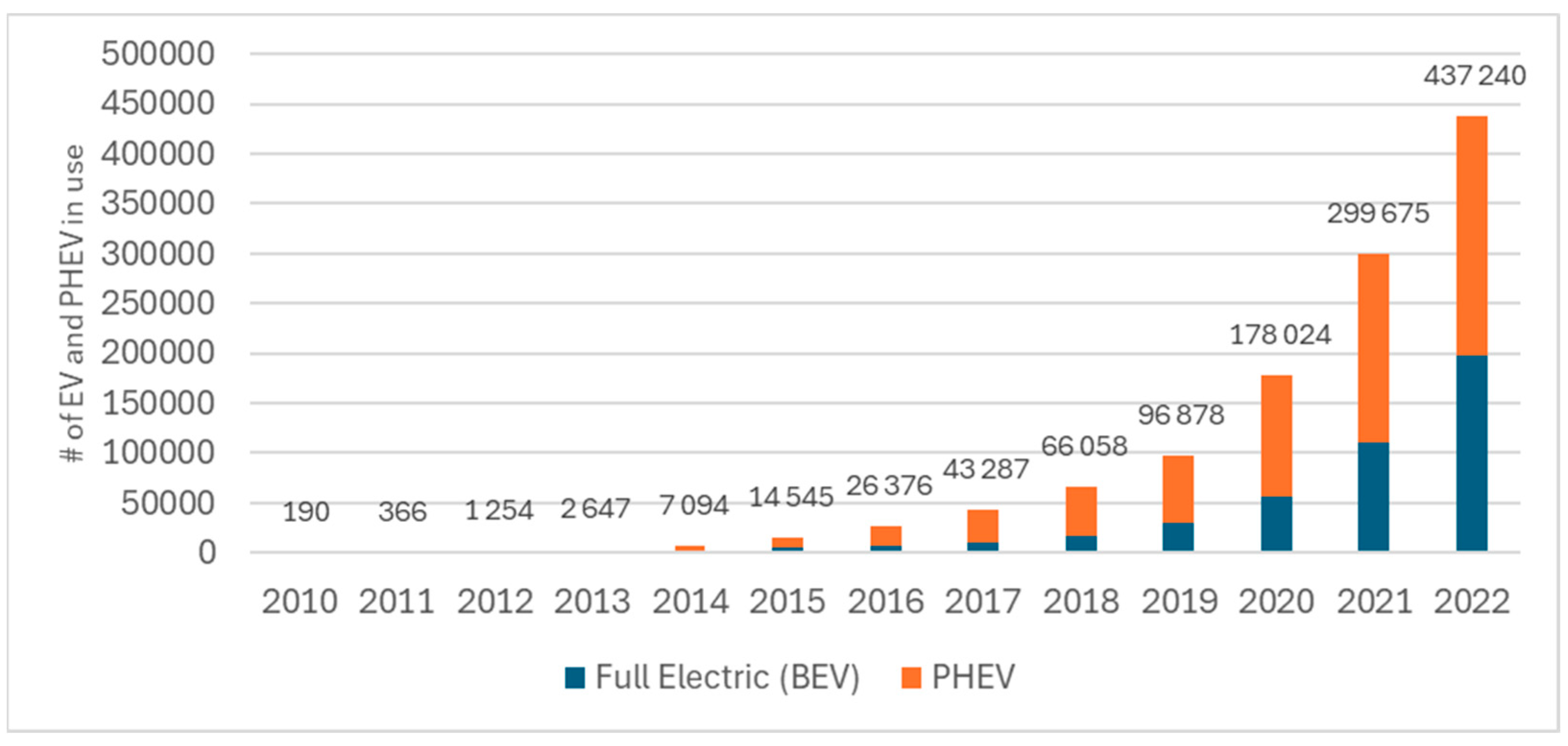
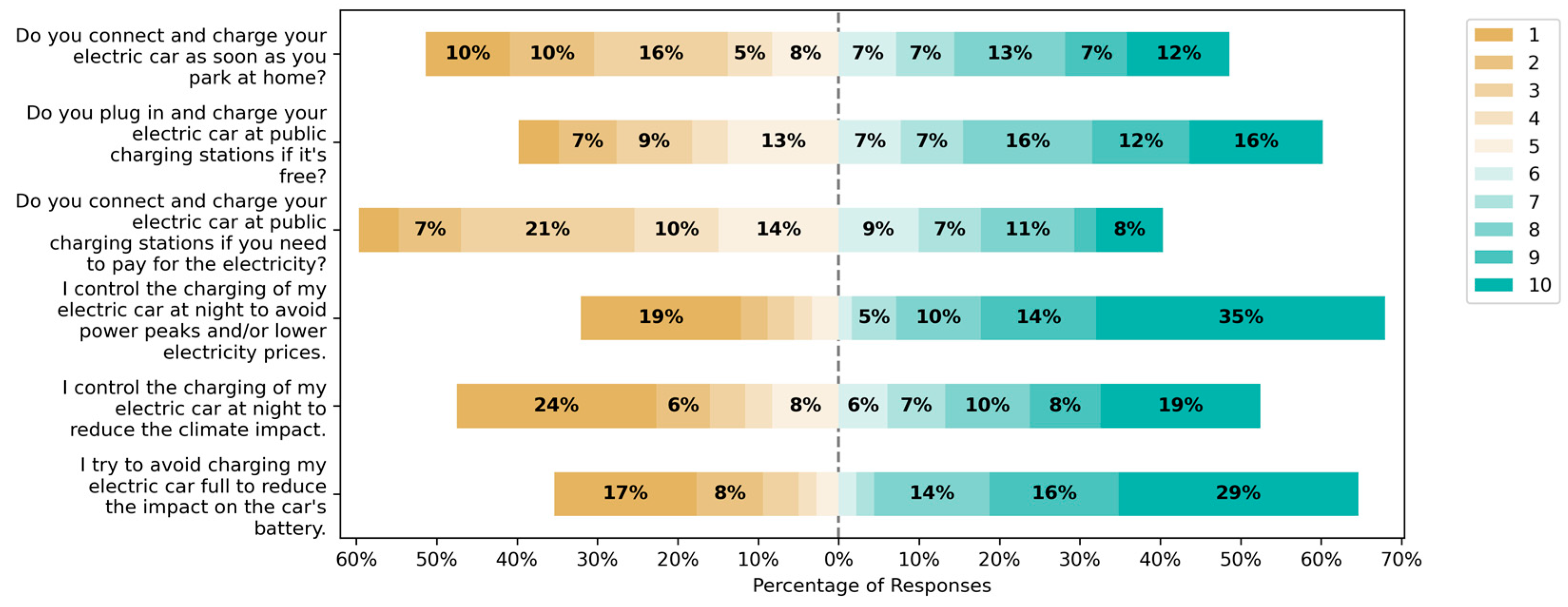
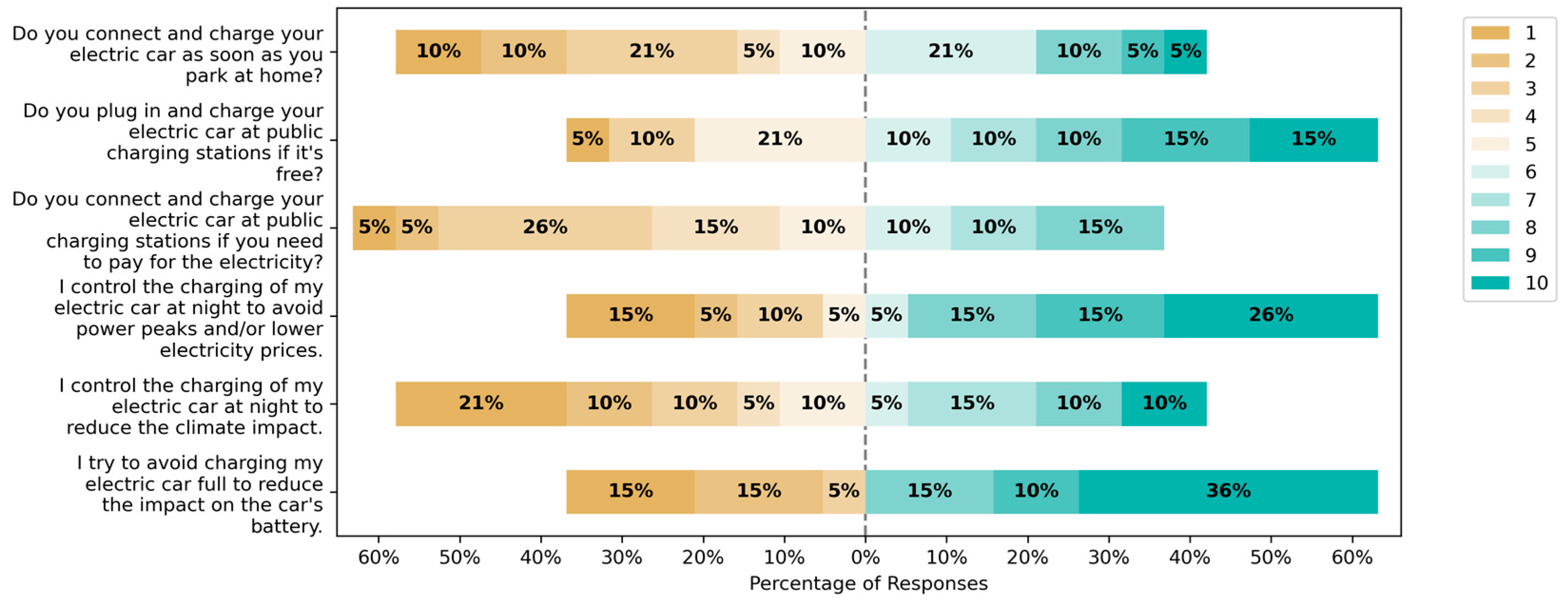
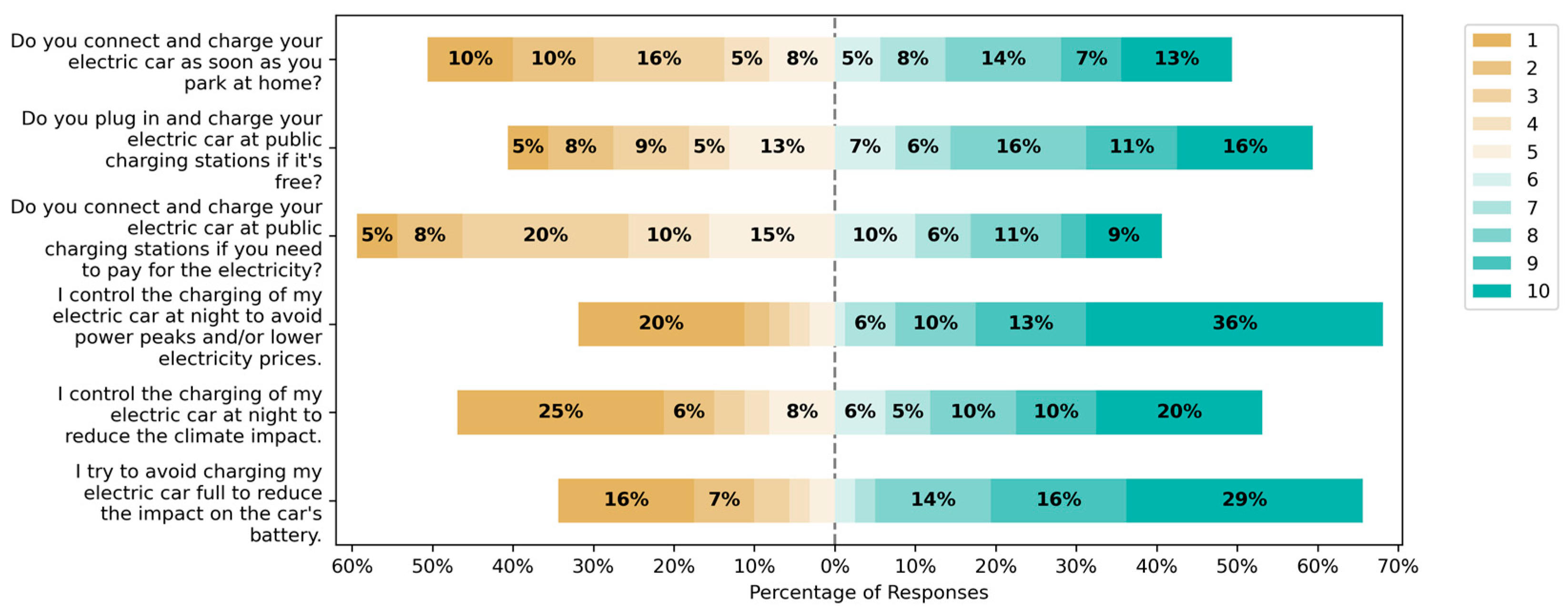
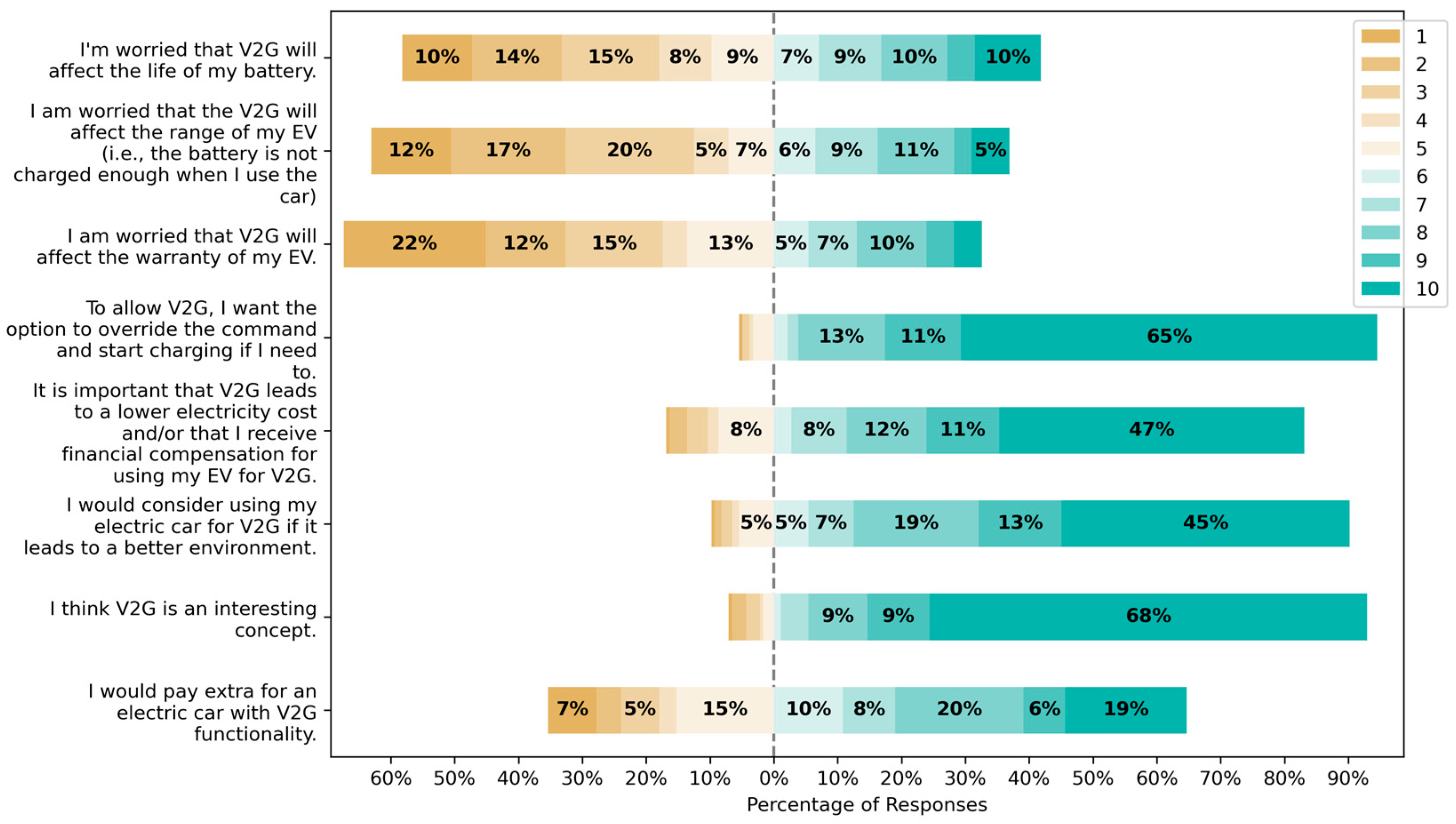
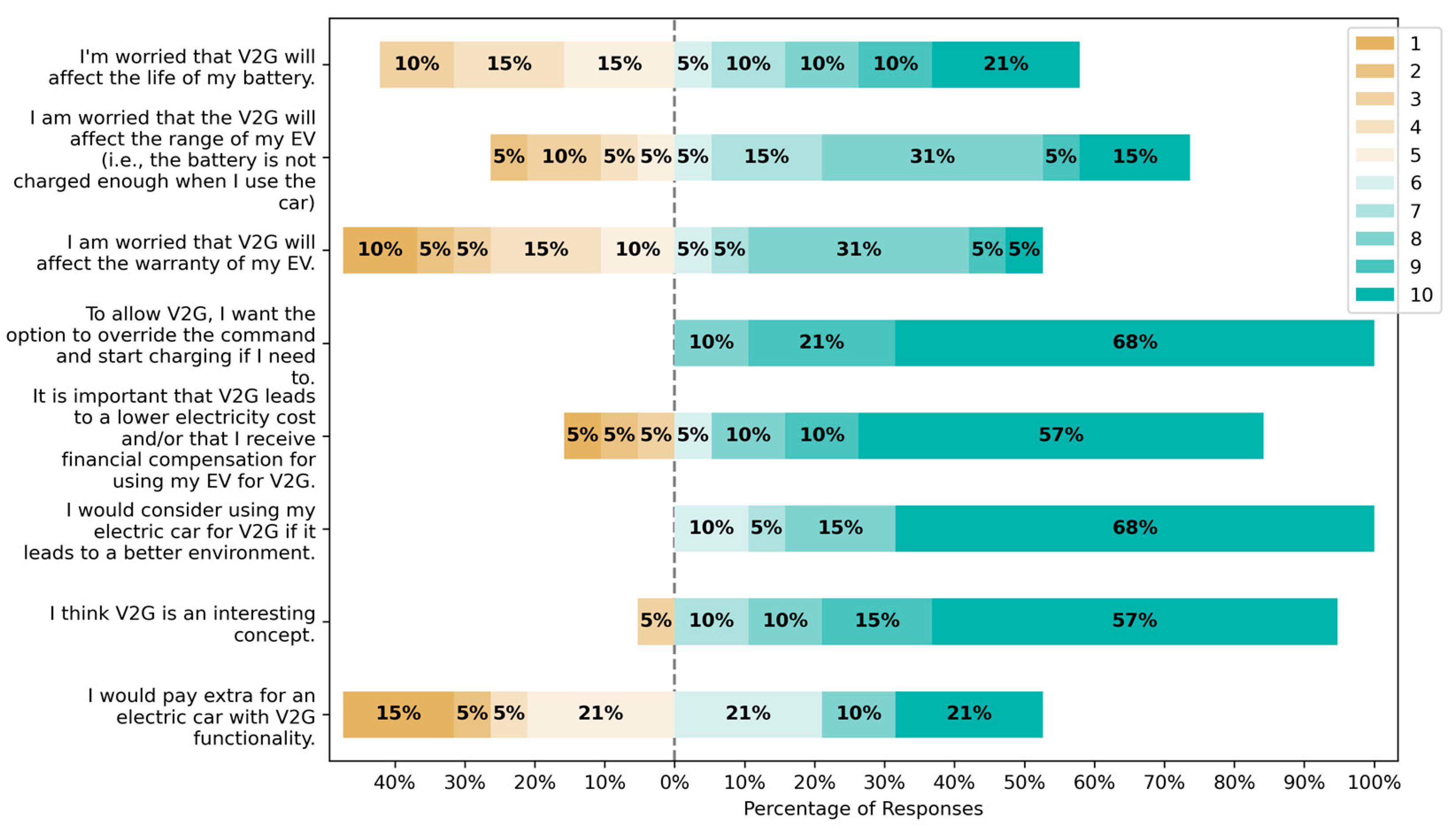
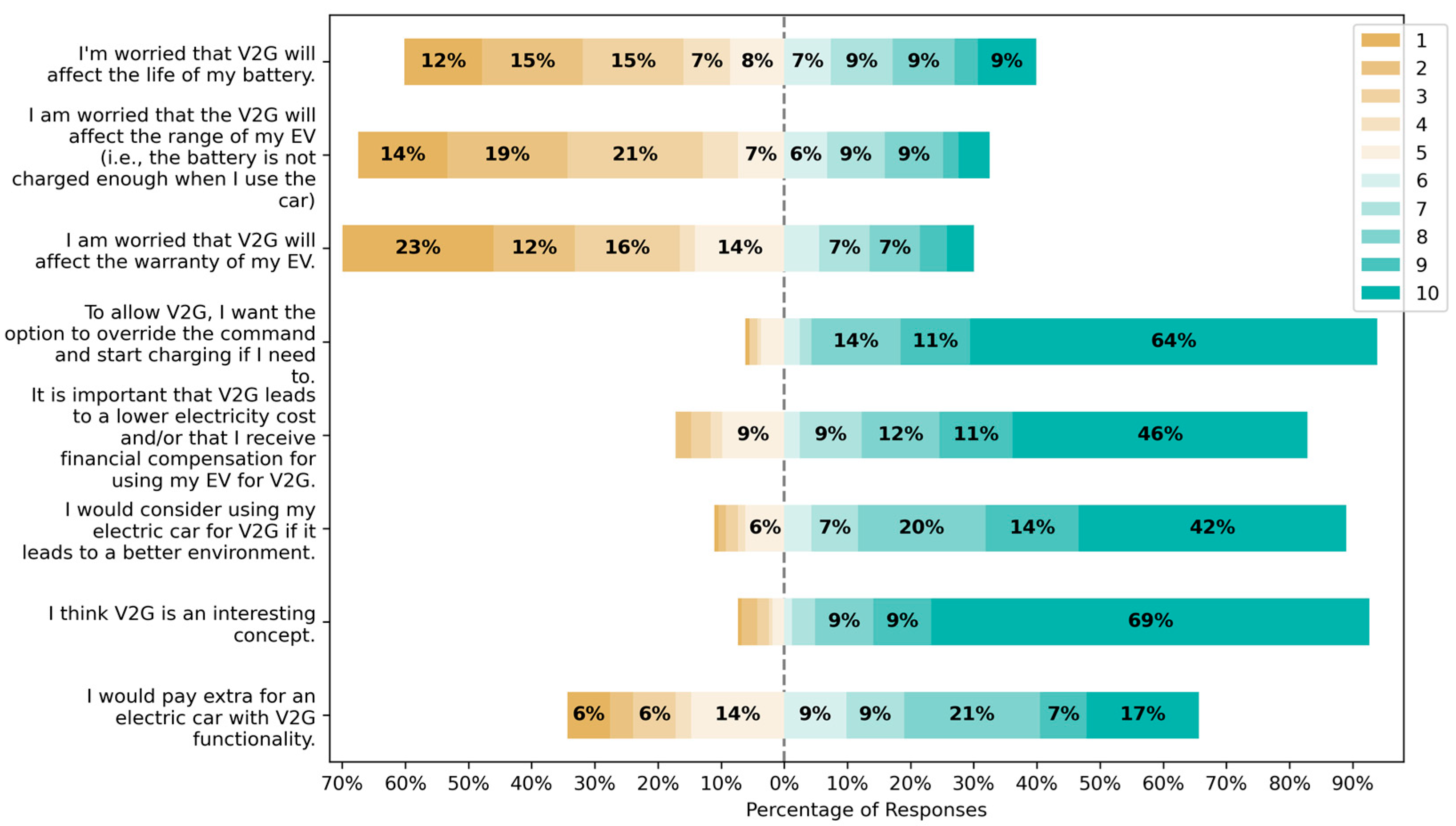
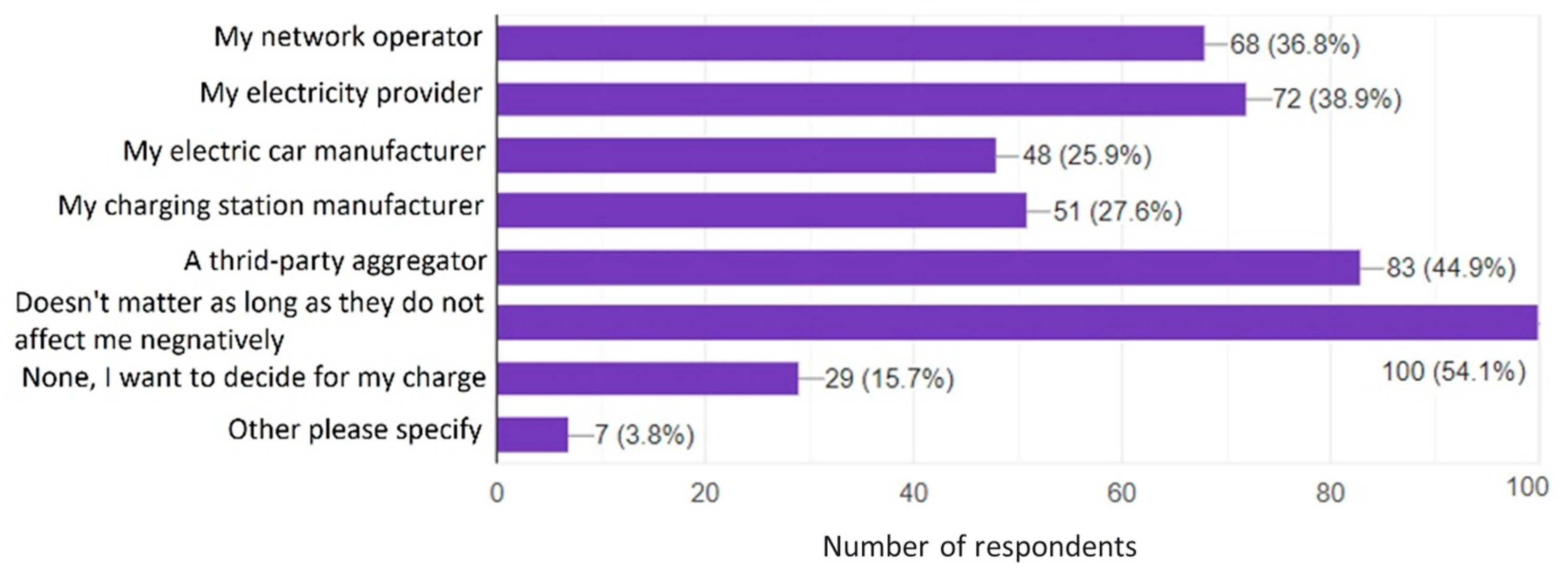
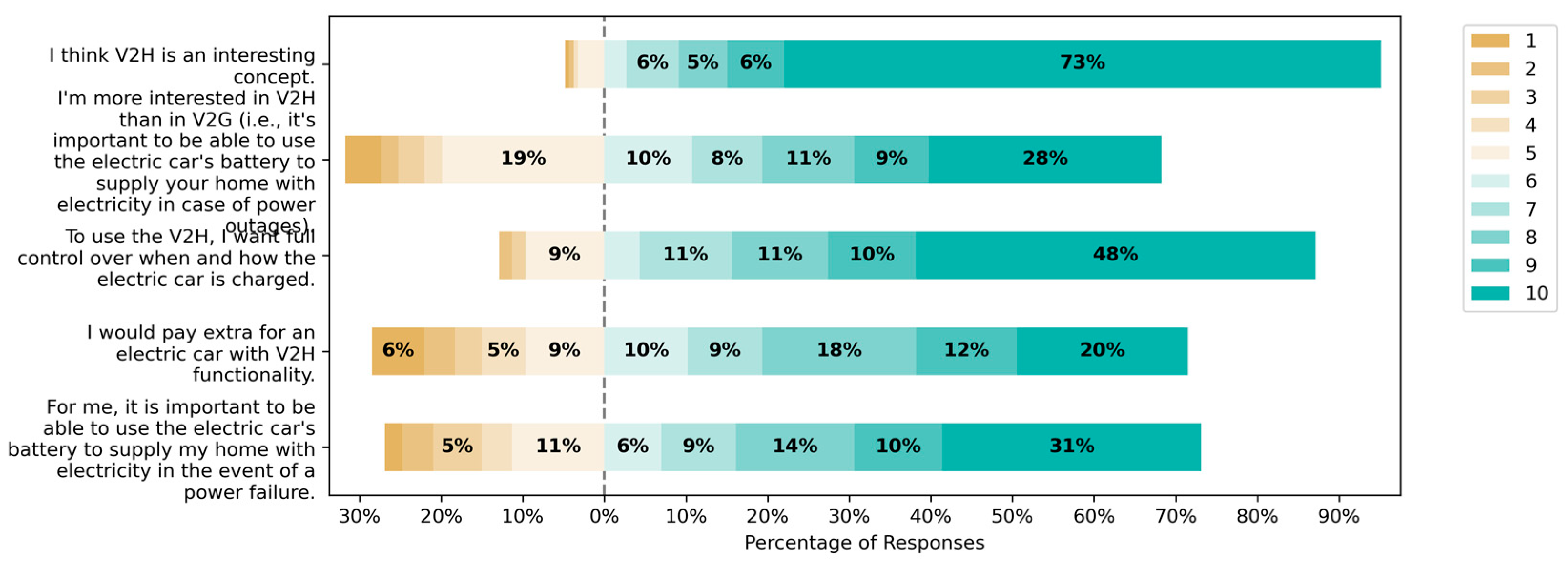
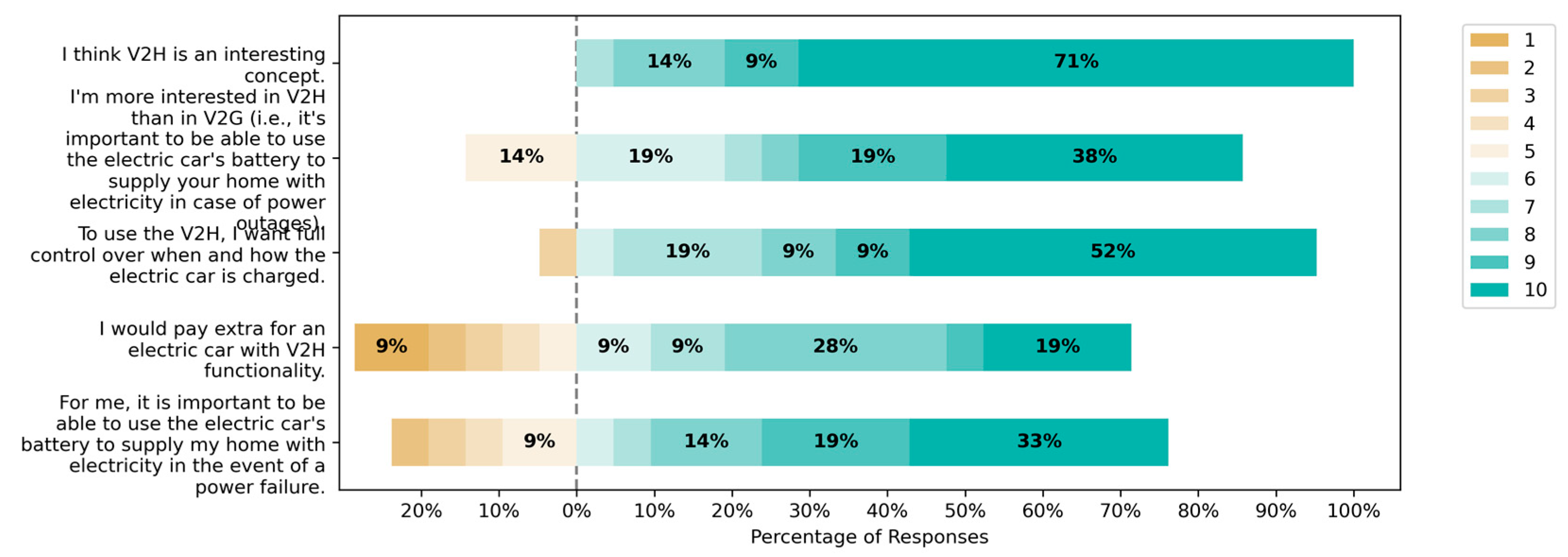
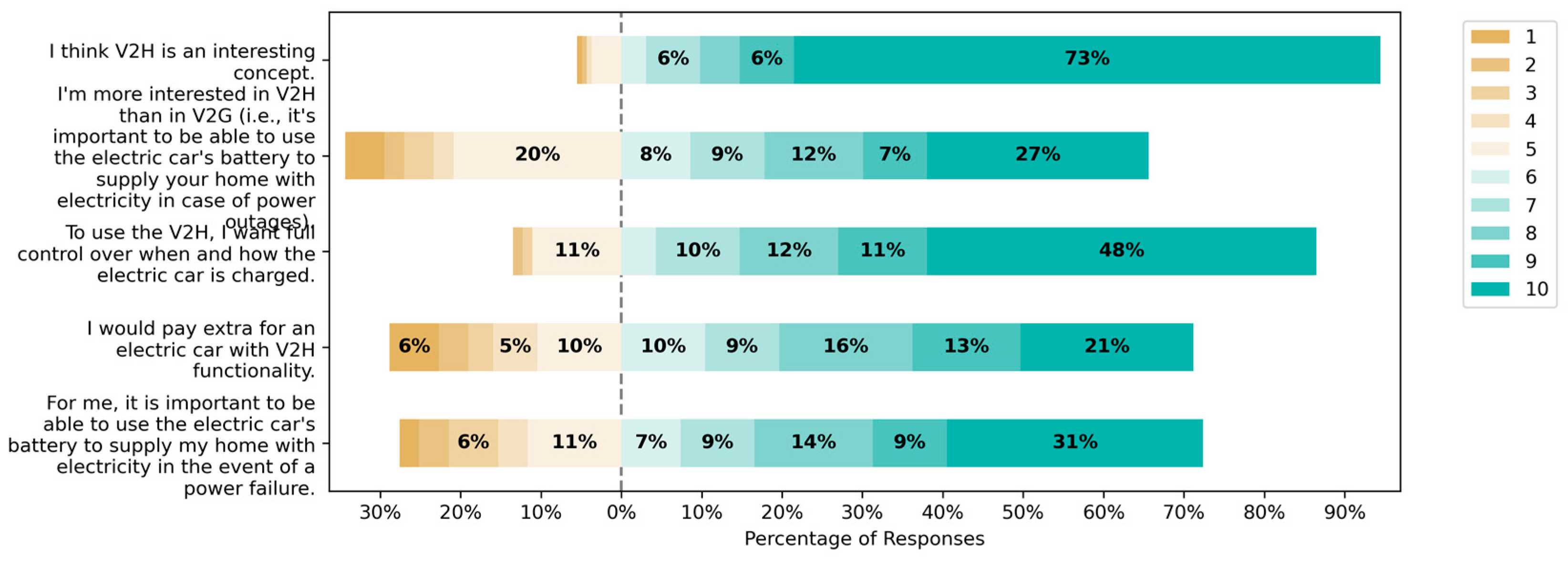
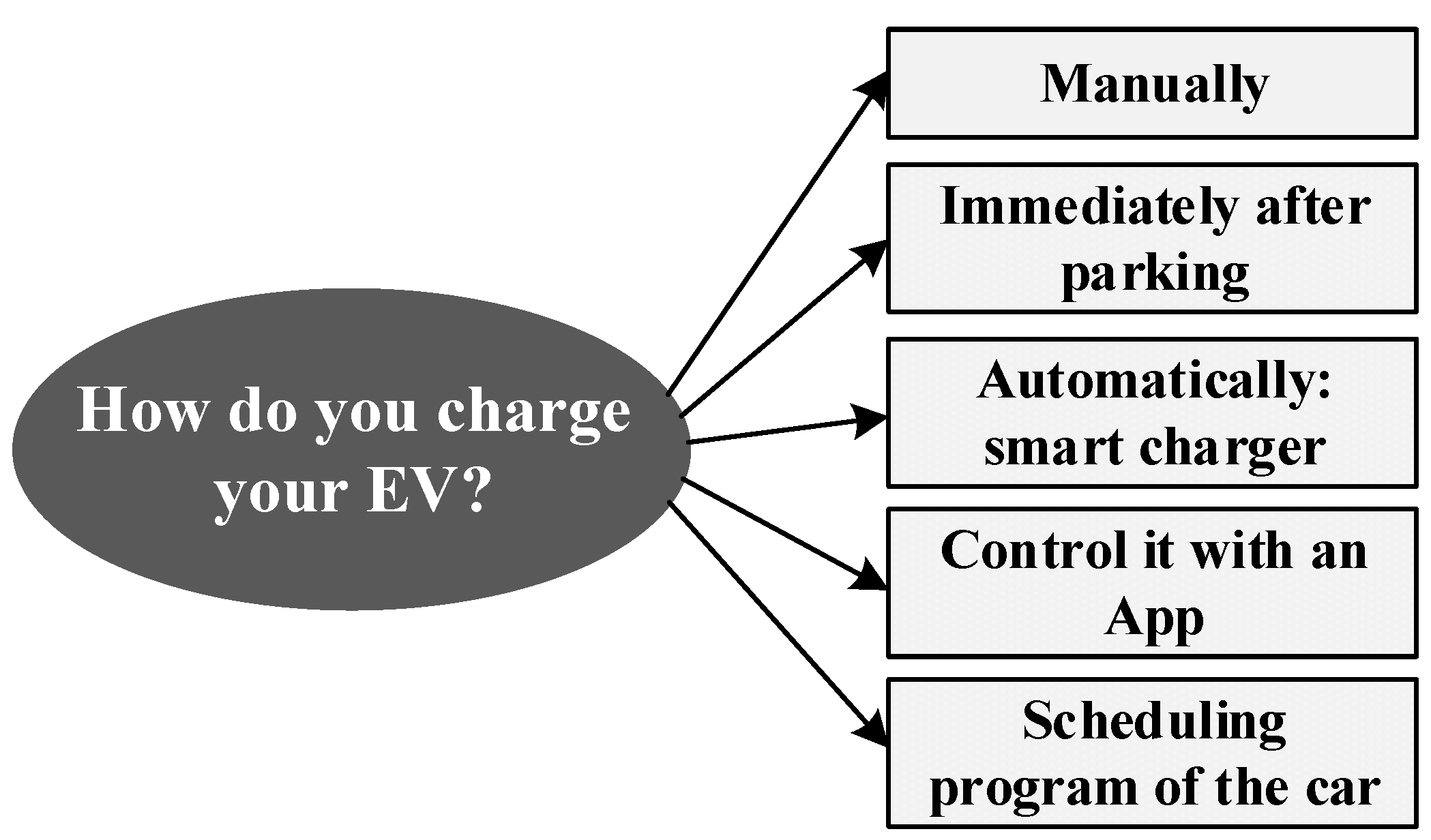
| Context | Questions/Statements | Answer Alternatives | |
|---|---|---|---|
| General background information | 1 | Gender? | Male/Female/Don’t want to say |
| 2 | Accommodation type? | Singel-family house/Town house, Apartment/Other | |
| 3 | Do you have an electric car today? | Yes/No, but I plan to buy one soon/No | |
| 4 | Parking/Charging option you use today? | Private/rented parking with charge possibility Private/rented parking without charge possibility Residential/street parking with charge possibility Residential/street parking without charge possibility Other | |
| Claims related to their EV charging | 1 | Do you connect and charge your electric car as soon as you park at home? | 1 (Don’t agree)–10 (Fully agree) |
| 2 | Do you plug in and charge your electric car at public charging stations if it’s free? | 1 (Don’t agree)–10 (Fully agree) | |
| 3 | I control the charging of my electric car at night to avoid power peaks and/or lower electricity prices. | 1 (Don’t agree)–10 (Fully agree) | |
| 4 | I control the charging of my electric car at night to reduce the climate impact. | 1 (Don’t agree)–10 (Fully agree) | |
| 5 | I try to avoid charging my electric car in full to reduce the impact on the car’s battery. | 1 (Don’t agree)–10 (Fully agree) | |
| 6 | Do you connect and charge your electric car at public charging stations if you need to pay for the electricity? | 1 (Don’t agree)–10 (Fully agree) | |
| V2G integration with EV | 1 | I think V2G is an interesting concept. | 1 (Don’t agree)–10 (Fully agree) |
| 2 | I’m worried that V2G will affect the life of my battery. | 1 (Don’t agree)–10 (Fully agree) | |
| 3 | I am worried that the V2G will affect the range of my electric car (i.e., the battery is not charged enough when I use the car). | 1 (Don’t agree)–10 (Fully agree) | |
| 4 | I am worried that V2G will affect the warranty of my electric car. | 1 (Don’t agree)–10 (Fully agree) | |
| 5 | For me, it is important that V2G leads to a lower electricity cost for me and/or that I receive financial compensation for using my electric car for V2G. | 1 (Don’t agree)–10 (Fully agree) | |
| 6 | I would consider using my electric car for V2G if it leads to a better environment. | 1 (Don’t agree)–10 (Fully agree) | |
| 7 | I would pay extra for an electric car with V2G functionality. | 1 (Don’t agree)–10 (Fully agree) | |
| 8 | I could use the following companies to control the charge and discharge. |
| |
| 9 | To allow V2G, I want the option to override the command and start charging if I need to. | 1 (Don’t agree)–10 (Fully agree) | |
| V2H application by EV | 1 | I think V2H is an interesting concept. | 1 (Don’t agree)–10 (Fully agree) |
| 2 | I’m more interested in V2H than in V2G (i.e., it’s important to be able to use the electric car’s battery to supply your home with electricity in case of power outages). | 1 (Don’t agree)–10 (Fully agree) | |
| 3 | To use the V2H, I want full control over when and how the electric car is charged. | 1 (Don’t agree)–10 (Fully agree) | |
| 4 | For me, it is important to be able to use the electric car’s battery to supply my home with electricity in the event of a power failure. | 1 (Don’t agree)–10 (Fully agree) | |
| 5 | I would pay extra for an electric car with V2H functionality. Please specify below. | 1 (Don’t agree)–10 (Fully agree) | |
| Male | Female | Other/Don’t Want to Say |
|---|---|---|
| 165 | 22 | 2 |
| Apartment | Singel-Family House | Town House | Other |
|---|---|---|---|
| 28 | 145 | 13 | 3 |
| Yes | No, but I Plan to Buy One | No | Other |
|---|---|---|---|
| 171 | 12 | 4 | 2 |
| Private/Rented Parking with Charger | Private/Rented Parking without Charger | Street Parking with Charger | Street Parking without Charger | Other |
| 145 | 11 | 22 | 4 | 6 |
| Context | Comments/Statements Made by the Respondents |
|---|---|
| Charging options | “Villa with its own garage, charging possibilities both in the garage and in the garage driveway” “Country place for me or siblings with charging for two cars 11 kW and 3.6 kW” “We live in the countryside and charging possibilities in addition to our own charging box at home are limited.” “Has car with 220 V socket 16 A and the possibility to charge another electric car” “Charging at work mainly. Secondly, malls and other public chargers” “Has the possibility of charging in a holiday home” “Access to parking with charging at my workplace within walking distance of home.” “Summer cottage with charging box” “Probably 95% at home.” “Living in the country has charger for family’s 2 electric cars + guest charging point” |
| Context | Comments/Statements Made by the Respondents |
|---|---|
| How do you charge your EV? | “Have solar cells on the roof so charge when the sun shines the most and I get the most power, usually after 12 o’clock on a sunny day. In winter, I charge in the evening after 9 pm if I don’t need the car at the time and the battery is uncharged (for planned trip).” “I have an Easee charger that my electricity supplier supports (Tibber) which makes charging smart. It shows how many percent I want charged to and when I’m going away in the morning. Based on this, it looks at the price of electricity and when it is most advantageous to charge.” “Control the charging with the car’s scheduling so that it charges to 80 percent at night and is heated when it’s time to leave in the morning. On weekends, it is allowed to charge 100 percent, in case there is a longer excursion planned.” “I charge just over 1800 kWh per month. The price is not very important. What is required is intelligence in the car and the charger, i.e., that you can set up “rules” how it should work.” “I plug in the car at home but don’t charge until the night. What public charging stations? There is a big difference between destination charging and fast charging, you have to distinguish between that. I never use public destination charging, I just do it at home. I only use public fast chargers and I do that when I make longer trips. At home, I charge slowly, 8 A single phase, at night.” “Control manually. In the summer months mainly during the daytime to utilize power from own solar cells. In the winter months mainly evening/weekend. Only fully loaded for long journeys, otherwise to 80% SOC.” “We charge at home when needed. But usually overnight and that the charging is ready until about 05:00 as we control through the car’s built-in schedule, this to help with the balancing of the electricity grid, we have fixed electricity subscription for three more years, so we don’t really have to care. The car and box we have is one that can receive and deliver 22 kW, but we have only secured up to 25 A, so we do not get the maximum speed at home. Before, we had about 17 miles of round-trip commuting, hence a little more important for us with fast AC charging. Our house is heated with a waterborne electric boiler so having an hourly rate on the electricity is not an option for us until we change the heating system.” “Try to charge during the day in the summer with our own solar cells on the roof. In December with record electricity price, I cancelled night charging so I would say I have to save at least 500 SEK to control my charging.” “Charging to 80%, if necessary, thus does not charge after each drive, if there is a need for longer mileage charging to 100%, no steering against time or price, today has regular fuse subscription, so the only thing that limits is the main fuse, so usually the car is charged with about half the maximum charging current” “I have a variable monthly price, so when in the day I charge does not affect the cost. However, for fun, I have in recent months manually controlled the charging to times when an intended hourly charge has been low. So, it is not primarily the savings, but being able to influence the load on the mains, that makes me adjust the charging. Charging to 70% and to full of preheating of the car when I’m going far.” “In addition to electricity price control, I myself have implemented a power control that controls the charging power in such a way that the total hourly power output from the grid does not exceed a present level, due to the power tariff. Charging at night saves me in the order of SEK 100/month and optimizing the charging power against the power tariff saves me about 250 SEK/month.” |
| Context | Comments/Statements Made by the Respondents |
|---|---|
| Are there other aspects that affect whether you would use your electric car to deliver V2G services? How much would you need to save/earn per month for it to be relevant to use your electric car for V2G? Or would you like to clarify the answer above? | “But the kickback has to be hefty for me to be interested. Kind of free charging. My potential marginal cost must be lower than the electricity company’s margin gain. So, selling the electricity three times my purchase price (including taxes, fees and network charges) is the absolute lowest. Five times would be reasonable, and ten times would be a no-brainer.” “It would have been nice if you could save the equivalent of a higher price for the electric car in about 5 years, but it is not a requirement, I mostly want to participate in the technology development.” “The financial incentive must be significant. Alternatively, the car manufacturer includes an extended battery warranty as long as you offer your battery to the V2X.” “Depends on negative impact on the car’s economy/warranties/battery life. Sees primarily the possibility of V2V as interesting rather than V2G (although V2V also facilitates for G because the house consumption is evened out).” “The compensation must at least correspond to “wear and tear”/depreciation. The key question is which manufacturers allow V2G and under what forms. There is a clear conflict between the interest and priority of the owner and the manufacturer.” “I believe in selling flexibility services. Want to be sure that there is at least 70–80% charging when I need it (I can specify the time in advance). Economics is not unimportant (fair compensation) but climate and system benefits even more important.” “The most important thing is that the car is sufficiently charged when I need it and that any cost of wear and tear/impact on the car is weighed up by some kind of compensation for the electricity one contributed.” “The question is, after all, whether it is worth it to pay more for a charging box and electric car that enables the V2X in the end, and who profits the most? Is it worth it for me as a prosumer (i.e., do I get compensation for the service)? Is it network crew that feels it (i.e., it frees up power cache - but then they probably need to pay compensation to V2G customers). What is the net effect on society?” “I would love to use the car as a power bearing for the hours of the day when the electricity is at its most expensive, and then charge it when it is at its cheapest. However, there are no technical conditions for it today where I live - in rental housing. I would love to earn something, but it doesn’t have to be much as long as the investment is not so big. I need to buy a car anyway, unlike solar cells which are a big cost and take a relatively long time to earn.” |
| Context | Comments/Statements Made by the Respondents |
|---|---|
| Are there other aspects that affect whether you would use your car for V2H services? Or would you like to clarify the answer above? | “A little doubtful if the V2H is worth it from an economic perspective as it would probably require a lot of other “smart gadgets” to control it (maybe even a separate DC network or similar to avoid losses etc.).” “The question is, does the network owner allow it? Have battery for the solar cells today and it must have power to work, i.e., if the power goes, I have no use of the battery. Off-grid solutions only work if they are always completely off the grid.” “The use of the car for V2H requires some investment in the property’s electricity network so as not to risk trying to supply the entire electricity grid in the event of an outage, this is a factor to take into account.” “I think you have to think V2G and V2H together. Only if you get both can it get so interesting that I want to pay for it. And it must be able to be connected to the existing solar cell system.” “I am prepared to pay 10 thousand SEK extra or even more to get V2H support in the car. I don’t have to buy an extra battery for the house. However, the system must of course be able to cope with island operation otherwise it is not interesting.” “My electrical installation must be built for V2H for it to be usable. The installation must be approved by the network owner for the necessary security for network owner personnel.” “Automated V2G I think is more interesting than V2H. Power outages are so rare that if a well-developed V2G is in place, the arguments for V2H decrease in my opinion. V2L, on the other hand, could be more interesting in that case. But the most important thing is that all cars in the future support the V2X in some form.” “How easy it is for me as a user to control. A good electricity trading agreement where I can save money and see the climate benefits of using the car battery as stock.” |
Disclaimer/Publisher’s Note: The statements, opinions and data contained in all publications are solely those of the individual author(s) and contributor(s) and not of MDPI and/or the editor(s). MDPI and/or the editor(s) disclaim responsibility for any injury to people or property resulting from any ideas, methods, instructions or products referred to in the content. |
© 2024 by the authors. Licensee MDPI, Basel, Switzerland. This article is an open access article distributed under the terms and conditions of the Creative Commons Attribution (CC BY) license (https://creativecommons.org/licenses/by/4.0/).
Share and Cite
Khezri, R.; Steen, D.; Anh Tuan, L. Willingness to Participate in Vehicle-to-Everything (V2X) in Sweden, 2022—Using an Electric Vehicle’s Battery for More Than Transport. Sustainability 2024, 16, 1792. https://doi.org/10.3390/su16051792
Khezri R, Steen D, Anh Tuan L. Willingness to Participate in Vehicle-to-Everything (V2X) in Sweden, 2022—Using an Electric Vehicle’s Battery for More Than Transport. Sustainability. 2024; 16(5):1792. https://doi.org/10.3390/su16051792
Chicago/Turabian StyleKhezri, Rahmat, David Steen, and Le Anh Tuan. 2024. "Willingness to Participate in Vehicle-to-Everything (V2X) in Sweden, 2022—Using an Electric Vehicle’s Battery for More Than Transport" Sustainability 16, no. 5: 1792. https://doi.org/10.3390/su16051792
APA StyleKhezri, R., Steen, D., & Anh Tuan, L. (2024). Willingness to Participate in Vehicle-to-Everything (V2X) in Sweden, 2022—Using an Electric Vehicle’s Battery for More Than Transport. Sustainability, 16(5), 1792. https://doi.org/10.3390/su16051792






